Fire departments across the country, and especially in the West, have faced several years of lengthy wildland fire seasons with some of those fires growing to gargantuan sizes. Wildland apparatus manufacturers have worked with departments to fine tune their wildland and wildland urban interface (WUI) fire apparatus to give firefighters the best equipment possible to douse the flames.
At FDIC International 2023, E-ONE introduced its Defender™ Type 3 urban-interface pumper. The unit features full-height/full-depth rescue-style driver’s and officer’s side compartments; a tall rear compartment and enclosed tunnels for ladders and hard suction hose; a 500-gallon water tank and 20-gallon external foam tank; a 500-gallon-per-minute (gpm), two-stage, high-pressure PTO pump; and Weldon V-MUX multiplex electrical system with LCD. Its short-wheelbase 4×4 chassis with set-back front axle and high approach and departure angles provide off-road capability. It also features fabricated 304L stainless steel body sections that are double fastened for durability and reduced weight.
Peter Darley, executive vice president and chief operating officer of W.S. Darley & Company, says Darley developed a wildland interface pumper built on an all-wheel drive International CV™ chassis carrying a Darley PSM 1,500-gpm single-stage split-shaft midship pump, a 400-gallon water tank, a 25-gallon foam cell, and a Darley AutoCAFS system with a 120-cubic-feet-per-minute (cfm) air compressor. Darley notes the pumper has four 2½-inch discharges, one 3-inch discharge, and two 200-foot 1¾-inch crosslays.
“Our Wildland Interface Pumper uses a PolyBilt® body where the body and tank are incorporated as a unit, which maximizes compartment space and also saves on weight,” Darley points out. “The pumper is set up to carry a driver, an officer, and two firefighters in self-contained breathing apparatus (SCBA) seats; a three-section 20-foot extension ladder, a 10-foot roof ladder, and an 8-foot attic ladder; and three 6-inch hard suction hoses and 800 feet of 3-inch hose in the hosebed.”
He adds that the pumper is also available on a 4×4 Ford F-550 chassis with standard dual rear tires or with Super Single wheels and tires for rough wildland settings. Darley notes that both designs are engineered to get to fire or emergency incidents quickly and into places that a full-size pumper can’t access. “With four-wheel drive and a height of approximately 8 feet, first responders have more available access options,” he points out.
Kevin Sofen, Darley’s director of innovation, says that Darley is developing a Ford Bronco® wildland rig upfitted by Darley tailored for incident command and resilient communications. “With the return of the Bronco, Ford Motor Company approached Darley to collaborate on a vehicle that would support wildland firefighters and agencies,” Sofen says. “We needed to build something that was easy to use; affordable; and created redundancy around communications, computation, and power. We sourced technology from vendors such as Kymeta, Dejero, Hypha, Stealth Power, Microsoft, 3AM, DroneSense, and Parrot that will be integrated within the Bronco. Since seamless communication is imperative in the wildland, each unit will have a satellite antenna on the roof for satellite connectivity, along with three LTE modem networks—AT&T FirstNet, Verizon, and T-Mobile—which will all be blended with the satellite communications for seamless connectivity no matter where the truck is located in the wildland.”
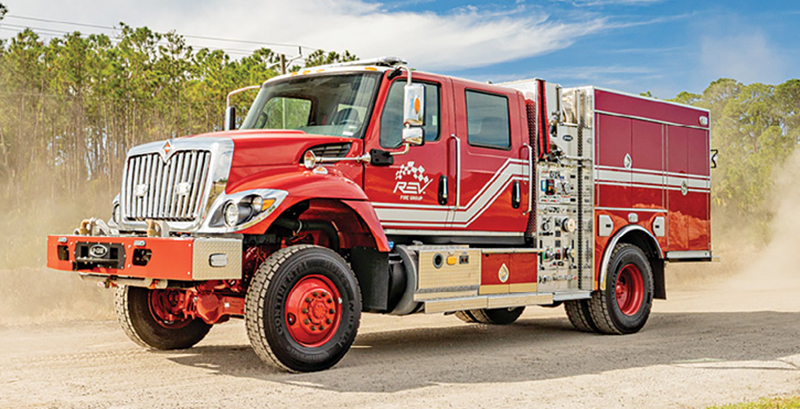
1 E-ONE introduced its Defender™ Type 3 urban-interface pumper that features full-height/full-depth rescue-style compartments; a 500-gallon water tank and 20-gallon external foam tank; and a 500-gpm, two-stage, high-pressure PTO pump. (Photo courtesy of E-ONE.)
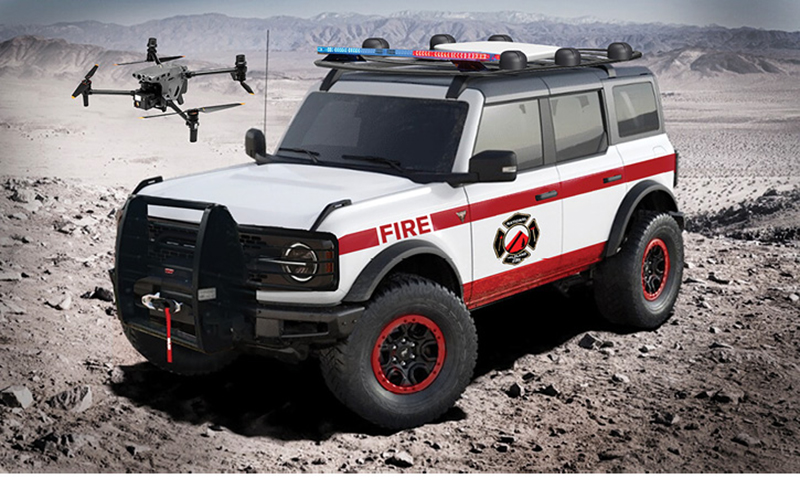
2 Darley is developing a Ford Bronco wildland rig that’s tailored to provide seamless communication at wildland incidents. (Photo courtesy of W.S. Darley & Company.)
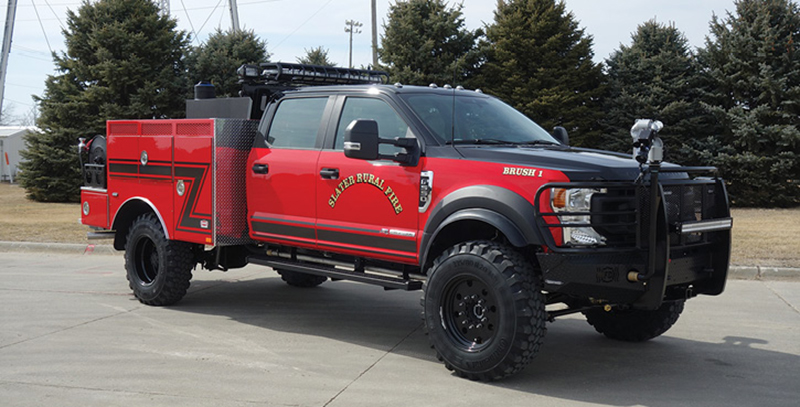
3 Danko Emergency Equipment Company built this Type 6 wildland engine for the Slater (MO) Rural Fire District. (Photo courtesy of Danko Emergency Equipment Company.)
Sofen says another system on the vehicle creates a mesh network, like a WiFi bubble around the truck. “The firefighters will have wearable devices that can be taken off the truck and extend the same connectivity from the vehicle all the way to the first responder up to a mile,” he says, “and additional nodes can be added to extend that range.” The Ford Bronco wildland rig also will incorporate drones, with the option of either tethered or free-flying models that will use a range of software to stream data back to an incident commander in real time.”
Mark Kreikemeier, president of Danko Emergency Equipment Company, says Danko “has provided a lot of options to wildland apparatus, responding to the choice of equipment that a fire department makes.” He notes that most departments choose either a Ford F-550 or Ram 5500 chassis, usually in four-wheel drive, and many of them go with Super Single wheels and tires with vehicle lift kits to avoid getting bogged down in soft ground.
Dave Knobbe, Danko’s apparatus sales manager, observes that front bumper monitors have become a common option on most wildland rigs, usually operated remotely from the cab to allow the rig to be crewed by a single firefighter. “Ground sweep spray bars are also a popular option,” Knobbe says, “and the rigs’ pumps typically run at 75 to 95 pounds per square inch (psi) to enable proper discharge pressure to feed a one-inch hose booster reel or either a front monitor or ground sweeps. Water tanks range from 200 gallons to 500 gallons for an apparatus with a two-door, extended cab or crew cab configuration. In the past year or so, just over half of our customers chose to have a foam system.”
Rob Wilkey, product manager for Pierce Manufacturing Inc., says Pierce builds the BX3 WUI engine on Freightliner MD-106 and International HV507 four-wheel-drive chassis and four-door configurations with bodies ranging from 118 to 152 inches.
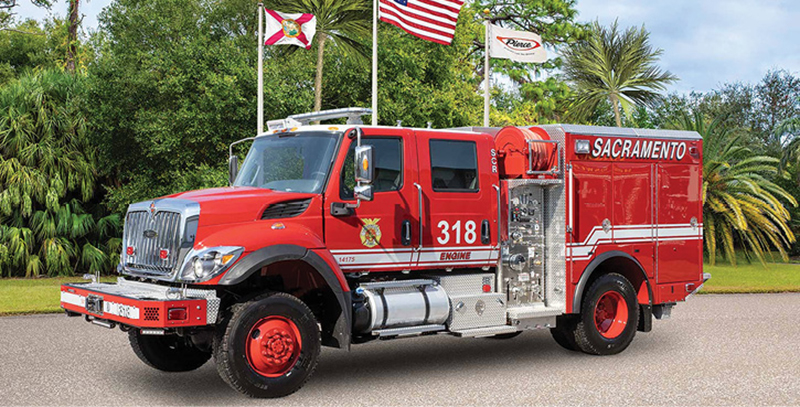
4 The Sacramento (CA) Fire Department had Pierce Manufacturing build this BX3 WUI engine on an International chassis with a four-door cab. (Photo courtesy of Pierce Manufacturing Inc.)

5 SVI Trucks built this Type 3 wildland engine on an International chassis and four-door cab for the Deer Trail (CO) Rural Fire Protection District. (Photo courtesy of SVI Trucks.)
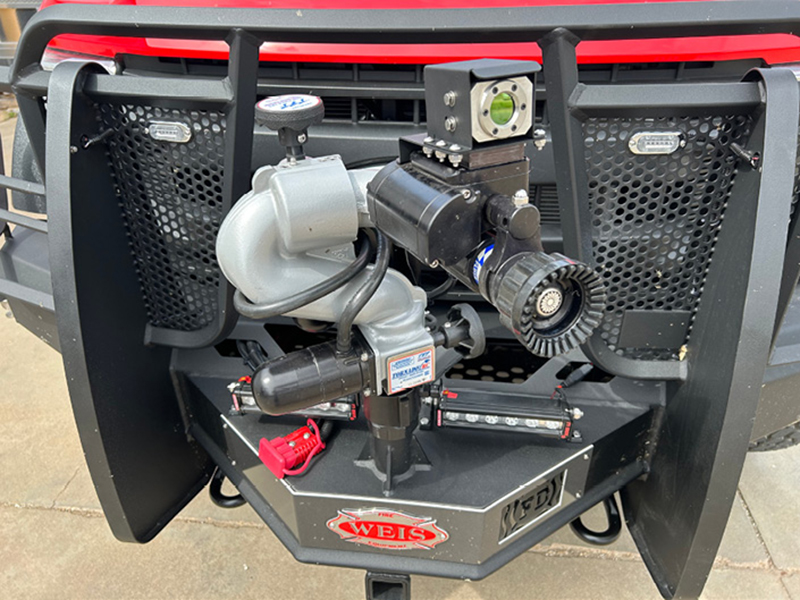
6 Weis Fire and Safety installed a thermal imaging camera on top of this wildland engine’s Task Force Tips Tornado remote-control bumper monitor. (Photo courtesy of Weis Fire & Safety.)
“The BX3 is a hybrid between a Type 1 and a traditional wildland rig,” Wilkey says. “We offer 500-gpm and 1,000-gpm midship pumps, an auxiliary pump for pump-and-roll, a 500-gallon water tank, ground sweeps on the front, a bumper turret, ladder storage through the body, and a lot of storage on top for additional gear and equipment.”
Joel Konecky, vice president of sales for SVI Trucks, says his company has been building more WUI pumpers recently, like a Type 1 WUI rig it built for the Deer Trail (CO) Fire Protection District on an International HV 4×4 chassis and four-door cab, powered by a Cummins 380-horsepower (hp) L9 engine and an Allison 3000 EVS automatic transmission.
Konecky says the WUI engine has a 1,250-gpm Waterous CX pump, a 1,000-gallon polypropylene water tank, a 20-gallon foam cell, a Waterous E511C 240-gpm auxiliary pump powered by a 3-cylinder Kubota diesel engine, and a FoamPro 1600 in-cab pump-and-roll foam controller. The rig also has a FRC PumpBoss pressure governor, an Akron Brass Company 1,250-gpm Apollo lift-off style deck monitor, front-bumper ground sweep nozzles, a Newton dump valve at the rear, a Ziamatic 12-VDC horizontal ladder access system, and OnScene Solutions LED compartment lighting.
SVI Trucks also builds Type 3 wildland engines on Freightliner and International 4×4 chassis in two- and four-door models, with main pumps from 250 to 1,500 gpm, auxiliary pumps for pump-and-roll capability, water tanks from 250 to 750 gallons, ground sweep nozzles, and deck guns. For Type 6 rigs, SVI uses Ford, Dodge, and Chevy truck chassis with two- or four-door cabs, carrying low- or high-pressure pumps, 300- to 400-gallon water tanks, 10- to 20-gallon foam tanks, deck guns, ground sweep nozzles, and booster reels.

7 Skeeter Emergency Vehicles built this Type 6 wildland engine with Super Single wheels and tires for Sabine (TX) Fire and Rescue. (Photo courtesy of Skeeter Emergency Vehicles.)
Wes Schamle, sales manager for Unruh Fire, notes that Unruh’s experience has been that departments are looking for bigger wildland vehicles. “As far as popularity goes, it seems like the bigger the truck the better,” Schamle observes. “We’re building wildland engines on Freightliner and International chassis that carry 1,000 gallons of water,” he says. “We’re also building rigs on the lighter Ford and Dodge chassis and putting Super Single wheels and tires on those light trucks.” He says a typical Unruh wildland engine would have a 14-foot flatbed body with a crosswalk, a Darley 100- to 250-gpm pump for pump-and-roll, an 800-gallon water tank, a 25-gallon Class A foam cell, and a Rowe compressed air foam system (CAFS) unit.
Unruh also is building wildland engines on International and Freightliner 6×6 chassis with 13½-foot aluminum flatbed bodies and crosswalks, Darley HE-500 pumps, 1,200-gallon water tanks, 15-gallon foam cells, and ATP Foam Flurry around-the-pump foam mixers. The 6×6 wildland rigs have transverse preconnected hose trays for 1½-inch hose, Hannay reels with 150 feet of one-inch booster hose, ditch sweep nozzles with console controls, 2½-inch discharges, 3-inch intakes, and two 2½-inch fill connections and Newton dump valves at the rear.
Mike Weis, owner of Weis Fire and Safety, believes one of the most recent innovations available to the fire service is thermal imaging on wildland vehicles. “These are not handheld devices; they are about 2×2×2 inches and fixed in place on the truck, typically attached to a front bumper with a protective shield around it,” Weis points out. “Some departments also attach a thermal imager to a remote-controlled front bumper monitor. The thermal images can be tied into the truck’s backup camera screen.”
Weis notes that he has been building more rigs designed as multipurpose apparatus. “A lot of departments are leaning toward WUI engines because, besides the need for a wildland brush truck, they also want the rig to be able to handle structure fires as well.”
Rob Pike, corporate services manager for Fort Garry Fire Trucks, points out that his company builds the Firewalker WUI engine on a Freightliner M2 chassis with four-door cab with a salt water marine-grade 5083 aluminum body. Pike says the Firewalker typically has a 1,250-gpm main pump, a Waterous CAFS for pump-and-roll, a 1,000- to 1,200-gallon water tank, a FoamPro foam proportioning system, an Akron Brass Fire Fox monitor on an extended front bumper, two crosslays, a Hannay booster hose reel, and a Federal Signal LED lighting package.
Bill Davidson, vice president of sales for Skeeter Emergency Vehicles (formerly Skeeter Brush Trucks), says Skeeter collaborated with Darley to introduce a mini/wildland pumper that can be built on an International CV 515 or Chevy 6500 two- or four-wheel-drive chassis. Davidson notes the rig can carry up to a 1,500-gpm midship-mounted pump, a Darley auxiliary pump for pump-and-roll, a 500-gallon water tank, crosslays, a front bumper monitor, and a hose reel.
Davidson adds that Skeeter recently purchased E.J. Metals, which will continue to operate as a separate division and produce wildland utility terrain vehicles (UTVs) outfitted with high-pressure pumps. “They have revamped some of their products and expanded into multipurpose UTVs with high-pressure pumps, hose reels, water tanks, storage areas, and space for a patient on a backboard or in a stokes,” he says.
ALAN M. PETRILLO is a Tucson, Arizona-based journalist, the author of three novels and five nonfiction books, and a member of the Fire Apparatus & Emergency Equipment Editorial Advisory Board. He served 22 years with the Verdoy (NY) Fire Department, including in the position of chief.

